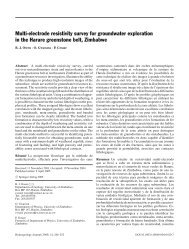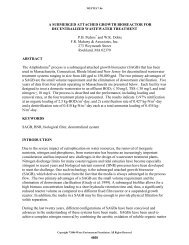Species diversity in the Florida Everglades, USA - Environmental ...
Species diversity in the Florida Everglades, USA - Environmental ...
Species diversity in the Florida Everglades, USA - Environmental ...
Create successful ePaper yourself
Turn your PDF publications into a flip-book with our unique Google optimized e-Paper software.
Aquat. Sci. Vol. 68, 2006 Overview Article 271<br />
nents. The orig<strong>in</strong>al material fl ow matrices (Ulanowicz et<br />
al., 2000; Ulanowicz et al., 1997) were processed to<br />
achieve <strong>the</strong>se requirements as follows:<br />
1) Flows, <strong>in</strong>itially reported <strong>in</strong> g C/m 2 /yr were converted<br />
to J/m 2 /yr assum<strong>in</strong>g an energy content of<br />
18.8 J/g C (organic).<br />
2) The matrices were transposed (<strong>in</strong>puts, or energy<br />
fl ows, to each component along rows, allocation<br />
of net production, or transfer, from each component<br />
along columns)<br />
3) Component steady state net production values<br />
(Flow 4 <strong>in</strong> Fig. 5b) were assigned to <strong>the</strong> ma<strong>in</strong> diagonal<br />
as negative numbers. This precluded any<br />
component (e.g. alligators) secur<strong>in</strong>g any portion<br />
of its diet from o<strong>the</strong>r <strong>in</strong>dividuals of <strong>the</strong> same component.<br />
4) Emergy fl ows were added as <strong>in</strong>puts. Exogenous<br />
emergy fl ows were split between primary producers<br />
based on steady-state stand<strong>in</strong>g stocks (g/m2)<br />
of photosyn<strong>the</strong>tically active material (i.e. leaves,<br />
but not wood and roots). These emergy <strong>in</strong>puts<br />
were <strong>in</strong>ferred from Brown and Bardi (2001), and<br />
were 5.2 × 10 11 and 1.3 × 10 11 sej/m 2 /yr for <strong>the</strong> wet<br />
and dry seasons for <strong>the</strong> gram<strong>in</strong>oid marsh.<br />
5) Flows of egested material were <strong>in</strong>troduced <strong>in</strong> <strong>the</strong><br />
matrix (<strong>the</strong>y were omitted from <strong>the</strong> orig<strong>in</strong>al matrices<br />
because that carbon was unassimilated; it is,<br />
however, a necessary component of each compartment’s<br />
production). To do this, each bilateral fl ow<br />
was multiplied by 2.5; it was assumed that an<br />
organism’s assimilation effi ciency (gross<br />
production/total <strong>in</strong>put) was constant across its<br />
sources of food. The sensitivity of <strong>the</strong> method to<br />
this assumption was not tested with<strong>in</strong> <strong>the</strong> scope of<br />
this work.<br />
Transformity calculations<br />
To compute transformities from <strong>the</strong>se network fl ow<br />
data, we used a l<strong>in</strong>ear optimization technique that manipulates<br />
a set of unknowns (transformity values) to<br />
meet a set of constra<strong>in</strong>ts (emergy <strong>in</strong>fl ow = emergy outfl<br />
ow). This particular set of constra<strong>in</strong>ts makes <strong>the</strong> tacit<br />
assumption that <strong>the</strong>re are no co-production modules <strong>in</strong><br />
<strong>the</strong> ecosystem; <strong>the</strong> method can be extended to allow coproduction,<br />
but this was unnecessary for <strong>the</strong> current data<br />
set.<br />
An example optimization table is given <strong>in</strong> Figure 6.<br />
Each row <strong>in</strong> Figure 6 represents a system component.<br />
The constra<strong>in</strong>ts to <strong>the</strong> right of each row follow from <strong>the</strong><br />
equality of emergy <strong>in</strong>fl ow and emergy outfl ow. Specifi -<br />
cally, <strong>the</strong> energy <strong>in</strong>puts multiplied by appropriate transformity<br />
values (unknowns <strong>in</strong> this case) equal <strong>the</strong> net<br />
production or transfer of energy multiplied by its transformity:<br />
Emergy Infl ow j = Σ i X ij *r i = Σ i X ji *r j = Emergy Outfl ow j (2)<br />
where X ij is <strong>the</strong> energy transfer from component i to component<br />
j, and τ i is <strong>the</strong> transformity value of respective<br />
fl ows.<br />
To avoid artifi cial overestimation of <strong>the</strong> transformity<br />
of fecal/senescent biomass contributions to detritus from<br />
high-quality components, we applied <strong>the</strong> follow<strong>in</strong>g<br />
rules:<br />
1) The transformity (sej/J) of a compartment is <strong>the</strong><br />
emergy (sej) from <strong>in</strong>com<strong>in</strong>g fl ows driv<strong>in</strong>g biotic<br />
production (Flow 1, Fig. 5b) divided by <strong>the</strong> energy<br />
(J) rema<strong>in</strong><strong>in</strong>g for trophic transfer (Flow 4 <strong>in</strong> Fig.<br />
5b).<br />
2) Where fl ows converge to abiotic components (e.g.<br />
detrital pools), <strong>the</strong> transformity of <strong>the</strong> <strong>in</strong>com<strong>in</strong>g<br />
fl ow is adjusted to <strong>the</strong> level of <strong>the</strong> detrital pool<br />
storage.<br />
A simple l<strong>in</strong>ear optimization method (Bardi et al.,<br />
2005) was applied to <strong>the</strong> processed matrix to estimate<br />
unknown transformities (sej/J) for each component.<br />
Hillier and Lieberman (1990) discuss <strong>the</strong> potential for<br />
“guess-and-check” methods to locate non-global solutions;<br />
because <strong>in</strong>put/output matrices used here<strong>in</strong> are<br />
square (# rows = # columns) and no l<strong>in</strong>earity assumptions<br />
are violated, this was considered impossible. The identifi<br />
cation of feasible solutions for <strong>the</strong> large number of<br />
constra<strong>in</strong>ts for all analyses required slight relaxation of<br />
<strong>the</strong> default precision for <strong>the</strong> Microsoft Excel Solver<br />
(Bardi et al., 2005).<br />
We compared transformity values across season (wet<br />
and dry) and exam<strong>in</strong>ed <strong>the</strong> stability of computed transformities<br />
by statistically compar<strong>in</strong>g an estimated regression<br />
slope to unity us<strong>in</strong>g standard <strong>in</strong>ferential techniques.<br />
System-level <strong>diversity</strong> <strong>in</strong>dex<br />
Quality-adjusted Shannon <strong>diversity</strong> is computed us<strong>in</strong>g<br />
Eq. 1 <strong>in</strong> <strong>the</strong> typical manner <strong>in</strong> ecology, except relative<br />
importance value (p i <strong>in</strong> Eq. 1) is defi ned as <strong>the</strong> proportion<br />
of total system emergy fl ow (sej/yr) allocated to each<br />
component. We refer to relative value calculated <strong>in</strong> this<br />
manner as <strong>the</strong> Emergy Importance Value (EIV) and compute<br />
it as follows:<br />
NPi *ri EIVi = (3)<br />
Σ j NPj *rj where NPj is <strong>the</strong> net production (J/yr) and τj (sej/J) is <strong>the</strong><br />
computed transformity of component i. In this formulation,<br />
importance value is <strong>the</strong> relative contribution of each<br />
component to <strong>the</strong> total emergy fl ow through all biotic<br />
components (i.e., denom<strong>in</strong>ator of Eq. 3), computed by<br />
summ<strong>in</strong>g net production times derived transformity over<br />
all components.
















